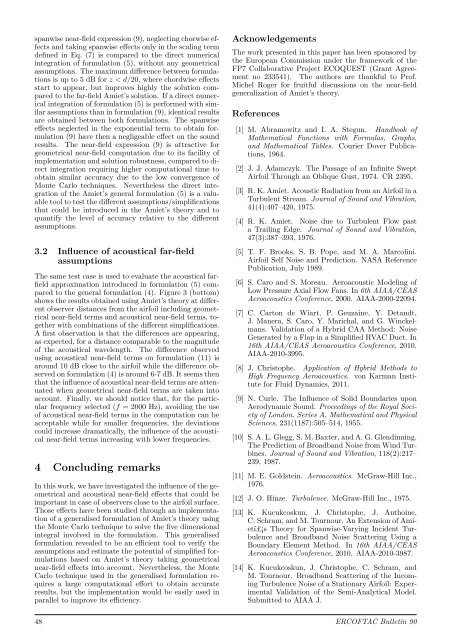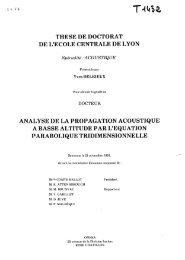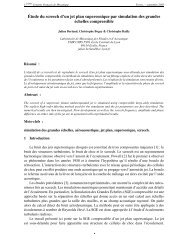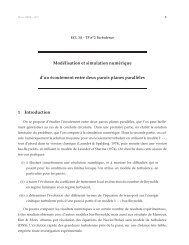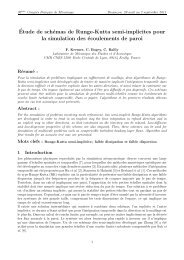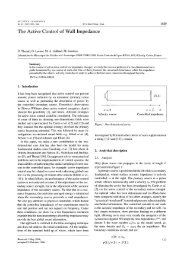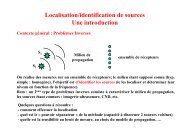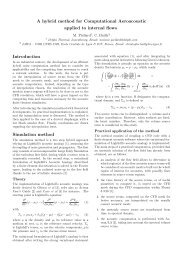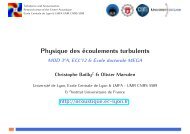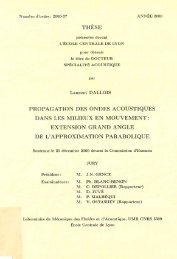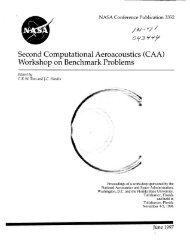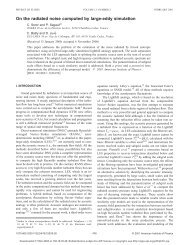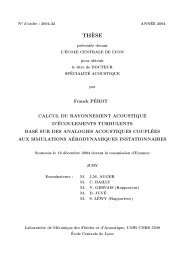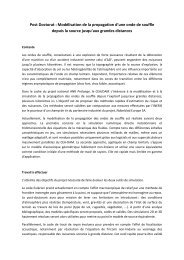ERCOFTAC Bulletin - Centre Acoustique
ERCOFTAC Bulletin - Centre Acoustique
ERCOFTAC Bulletin - Centre Acoustique
You also want an ePaper? Increase the reach of your titles
YUMPU automatically turns print PDFs into web optimized ePapers that Google loves.
spanwise near-field expression (9), neglecting chorwise effects<br />
and taking spanwise effects only in the scaling term<br />
defined in Eq. (7) is compared to the direct numerical<br />
integration of formulation (5), without any geometrical<br />
assumptions. The maximum difference between formulations<br />
is up to 5 dB for z < d/20, where chordwise effects<br />
start to appear, but improves highly the solution compared<br />
to the far-field Amiet’s solution. If a direct numerical<br />
integration of formulation (5) is performed with similar<br />
assumptions than in formulation (9), identical results<br />
are obtained between both formulations. The spanwise<br />
effects neglected in the exponential term to obtain formulation<br />
(9) have then a negligeable effect on the sound<br />
results. The near-field expression (9) is attractive for<br />
geometrical near-field computation due to its facility of<br />
implementation and solution robustness, compared to direct<br />
integration requiring higher computational time to<br />
obtain similar accuracy due to the low convergence of<br />
Monte Carlo techniques. Nevertheless the direct integration<br />
of the Amiet’s general formulation (5) is a valuable<br />
tool to test the different assumptions/simplifications<br />
that could be introduced in the Amiet’s theory and to<br />
quantify the level of accuracy relative to the different<br />
assumptions.<br />
3.2 Influence of acoustical far-field<br />
assumptions<br />
The same test case is used to evaluate the acoustical farfield<br />
approximation introduced in formulation (5) compared<br />
to the general formulation (4). Figure 3 (bottom)<br />
shows the results obtained using Amiet’s theory at different<br />
observer distances from the airfoil including geometrical<br />
near-field terms and acoustical near-field terms, together<br />
with combinations of the different simplifications.<br />
A first observation is that the differences are appearing,<br />
as expected, for a distance comparable to the magnitude<br />
of the acoustical wavelength. The difference observed<br />
using acoustical near-field terms on formulation (11) is<br />
around 10 dB close to the airfoil while the difference observed<br />
on formulation (4) is around 6-7 dB. It seems then<br />
that the influence of acoustical near-field terms are attenuated<br />
when geometrical near-field terms are taken into<br />
account. Finally, we should notice that, for the particular<br />
frequency selected (f = 2000 Hz), avoiding the use<br />
of acoustical near-field terms in the computation can be<br />
acceptable while for smaller frequencies, the deviations<br />
could increase dramatically, the influence of the acoustical<br />
near-field terms increasing with lower frequencies.<br />
4 Concluding remarks<br />
In this work, we have investigated the influence of the geometrical<br />
and acoustical near-field effects that could be<br />
important in case of observers close to the airfoil surface.<br />
Those effects have been studied through an implementation<br />
of a generalised formulation of Amiet’s theory using<br />
the Monte Carlo technique to solve the five dimensional<br />
integral involved in the formulation. This generalised<br />
formulation revealed to be an efficient tool to verify the<br />
assumptions and estimate the potential of simplified formulations<br />
based on Amiet’s theory taking geometrical<br />
near-field effects into account. Nevertheless, the Monte<br />
Carlo technique used in the generalised formulation requires<br />
a large computational effort to obtain accurate<br />
results, but the implementation would be easily used in<br />
parallel to improve its efficiency.<br />
Acknowledgements<br />
The work presented in this paper has been sponsored by<br />
the European Commission under the framework of the<br />
FP7 Collaborative Project ECOQUEST (Grant Agreement<br />
no 233541). The authors are thankful to Prof.<br />
Michel Roger for fruitful discussions on the near-field<br />
generalization of Amiet’s theory.<br />
References<br />
[1] M. Abramowitz and I. A. Stegun. Handbook of<br />
Mathematical Functions with Formulas, Graphs,<br />
and Mathematical Tables. Courier Dover Publications,<br />
1964.<br />
[2] J. J. Adamczyk. The Passage of an Infinite Swept<br />
Airfoil Through an Oblique Gust, 1974. CR 2395.<br />
[3] R. K. Amiet. Acoustic Radiation from an Airfoil in a<br />
Turbulent Stream. Journal of Sound and Vibration,<br />
41(4):407–420, 1975.<br />
[4] R. K. Amiet. Noise due to Turbulent Flow past<br />
a Trailing Edge. Journal of Sound and Vibration,<br />
47(3):387–393, 1976.<br />
[5] T. F. Brooks, S. B. Pope, and M. A. Marcolini.<br />
Airfoil Self Noise and Prediction. NASA Reference<br />
Publication, July 1989.<br />
[6] S. Caro and S. Moreau. Aeroacoustic Modeling of<br />
Low Pressure Axial Flow Fans. In 6th AIAA/CEAS<br />
Aeroacoustics Conference, 2000. AIAA-2000-22094.<br />
[7] C. Carton de Wiart, P. Geuzaine, Y. Detandt,<br />
J. Manera, S. Caro, Y. Marichal, and G. Winckelmans.<br />
Validation of a Hybrid CAA Method: Noise<br />
Generated by a Flap in a Simplified HVAC Duct. In<br />
16th AIAA/CEAS Aeroacoustics Conference, 2010.<br />
AIAA-2010-3995.<br />
[8] J. Christophe. Application of Hybrid Methods to<br />
High Frequency Aeroacoustics. von Karman Institute<br />
for Fluid Dynamics, 2011.<br />
[9] N. Curle. The Influence of Solid Boundaries upon<br />
Aerodynamic Sound. Proceedings of the Royal Society<br />
of London. Series A, Mathematical and Physical<br />
Sciences, 231(1187):505–514, 1955.<br />
[10] S. A. L. Glegg, S. M. Baxter, and A. G. Glendinning.<br />
The Prediction of Broadband Noise from Wind Turbines.<br />
Journal of Sound and Vibration, 118(2):217–<br />
239, 1987.<br />
[11] M. E. Goldstein. Aeroacoustics. McGraw-Hill Inc.,<br />
1976.<br />
[12] J. O. Hinze. Turbulence. McGraw-Hill Inc., 1975.<br />
[13] K. Kucukcoskun, J. Christophe, J. Anthoine,<br />
C. Schram, and M. Tournour. An Extension of Amiets<br />
Theory for Spanwise-Varying Incident Turbulence<br />
and Broadband Noise Scattering Using a<br />
Boundary Element Method. In 16th AIAA/CEAS<br />
Aeroacoustics Conference, 2010. AIAA-2010-3987.<br />
[14] K. Kucukcoskun, J. Christophe, C. Schram, and<br />
M. Tournour. Broadband Scattering of the Incoming<br />
Turbulence Noise of a Stationary Airfoil: Experimental<br />
Validation of the Semi-Analytical Model.<br />
Submitted to AIAA J.<br />
48 <strong>ERCOFTAC</strong> <strong>Bulletin</strong> 90


